Korean People's Army Ground Force
| 조선인민군 륙군 朝鮮人民軍 陸軍 Korean People's Army Ground Force | |
|---|---|
|
| |
| Founded | August 20, 1947 |
| Country |
|
| Allegiance |
|
| Type | Army |
| Size | 950,000 active |
| Part of |
|
| Equipment |
5,500 tanks 2,200 infantry fighting vehicles 8,600 artillery pieces 4,800 multiple rocket launcher systems |
| Engagements |
Korean War Syrian Civil War[2] |
| Commanders | |
| Commander-in-chief | General Ri Myong-su |
| Notable commanders | Choi Yong-kun, Kim Chaek |
| Former flag |
.svg.png) |
The Korean People's Army Ground Force (KPAGF; Chosŏn'gŭl: 조선인민군 륙군; Hanja: 朝鮮人民軍 陸軍) is the main branch of the Korean People's Army responsible for land-based military operations. It is the de facto army of North Korea.
History
The Korean People's Army Ground Force was formed on August 20, 1947. It outnumbered and outgunned the South Korean Army on the outbreak of the Korean War in June 1950. North Korean ground forces formations which fought in the Korean War included the I Corps, the II and III Corps. The IV Corps and V Corps, VI and VII Corps were formed after the outbreak of war. Divisions included the 105th Armored Division, the 1st, 2nd, 3rd, 4th, 5th, 6th, 7th, 8th, 9th, 10th, 12th, 19th, and 43rd Infantry Divisions. During the Korean War, it also contained a number of independent units such as the 766th Infantry Regiment.
In 1960, the KPAGF may have totaled fewer than 400,000 personnel and probably did not rise much above that figure before 1972. The force then massively expanded over the next two decades. In 1992, there were 950,000 personnel.[3] Before this expansion of the North Korean ground forces, the South Korean Army outnumbered the KPAGF. From the 1970s on, South Korea started exceeding North Korea in terms of economics. Thus, South Korea could modernize its forces, which in turn alerted North Korea and resulted in the expansion of the North Korean armed forces. Ironically, the weaker of the two Korea's has maintained the larger armed force. The size, organization, disposition, and combat capabilities of the Ground Force give Pyongyang military, albeit technologically inferior, possible options both for limited offensive operations to assault the lower half of the peninsula or for limited defensive operations against any perceived threat from South Korea.
Yossef Bodansky's Crisis in Korea, SP Books, 1994, gives an account of the North Korean order of battle in 1984-88 (p. 87-88).
Over time, this organization has adjusted to the unique circumstances of the military problem the KPA faces and to the evolution of North Korean military doctrine and thought.
In 1996 a significant portion of the staff, along with local government officials of the VI Corps was arrested and convicted of bribery and corruption.[4] The VI Corps HQ, which was in Chongjin, was in charge of military activities in the whole of North Hamgyong Province. It consisted of three infantry divisions, four rocket brigades and one artillery division. Joseph F. Bermudez reports in Shield of the Great Leader that the incident was not a coup, but it is often reported as such.[5] In any event, the corps was disbanded, and its units reallocated elsewhere, some to the IX Corps in North Hamgyong Province. The IX Corps now includes the 24th Division and the 42nd Division.
Current status
The overwhelming majority of active ground forces are deployed in three echelons — a forward operational echelon of four infantry corps; supported by a second operational echelon of two mechanized corps, the armor corps, and an artillery corps; and a strategic reserve of the two remaining mechanized corps and the other artillery corps.[6] These forces include the 806th and 815th Mechanized Corps and the 820th Armored Corps. These forces are garrisoned along major north-south lines of communication that provide rapid, easy access to avenues of approach into South Korea. The KPAGF has positioned massive numbers of artillery pieces, including some fakes, especially its longer-range systems, close to the Demilitarized Zone (DMZ) that separates the two Korea's.
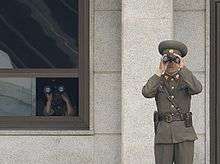
As of 2013, the US Department of Defense has reported the ground forces in number totals 950,000 in strength.[7]
Equipment
The Ground Forces have a mix of domestic and imported equipment in their inventory. Prior to the breakup of the Soviet Union, most of these items were Soviet made and later, from China.
Main sources: (note that this source is known to be quite outdated), ,
The annual report of North Korea's military capabilities by the U.S. Department of Defense, released in early 2014, identified the North Korean Army's strength at 950,000 personnel, 4,200 tanks, 2,200 armored vehicles, 8,600 artillery guns, and over 4,800 multiple rocket launchers.[8]
Armor
Today's KPA arsenal includes a mix of Soviet and Chinese products and locally produced armored vehicles.
| Name | Type | Quantity | Origin | Photo | Notes | |
|---|---|---|---|---|---|---|
| Tanks | ||||||
| T-34/85 | Main battle tank | ? | | Still in use. | ||
| Type 59 | Main battle tank | 175[9][10] | | 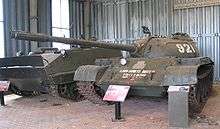 | Some 2,000 T-55 and Type 59 tanks are thought to currently be in service. | |
| T-55 | Main battle tank | 1,600[9] | | 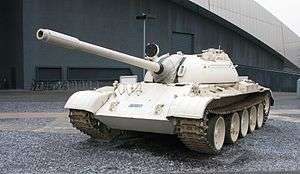 | Some 2000 T-55 and Type 59 Tanks are thought to currently be in service. Can be equipped with spaced armor to defeat HEAT warheads.[11] | |
| T-62M | Main battle tank | 800[9] | | 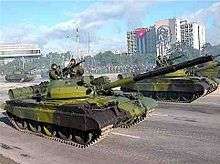 | Capable of receiving later model Ch'onma-Ho upgrades. | |
| Ch'ŏnma-ho | Main battle tank | ~1,000[9] | |  | 1,000 manufactured (as of the early 1990s). | |
| P'okpung-ho | Main battle tank | ~500 in service as of 2010 | | Locally designed main battle tank. Contains elements from T-62, T-72, Type 88, T-80 and T-90. | ||
| PT-76 | Amphibious light tank | 550 | | 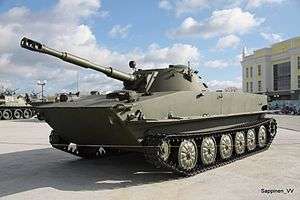 | Some PT-76 are in reserve status. | |
| Type 63 | Amphibious light tank | N/A | | 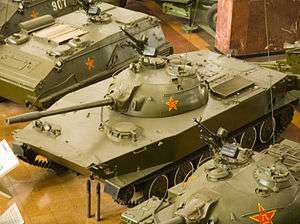 | [12] | |
| PT-85 (Type-82) | Amphibious light tank | N/A | |  | Based on the VTT-323 APC chassis. | |
| Armored Personnel Carriers & Infantry Fighting Vehicles | ||||||
| BMP-1 | Infantry fighting vehicle | 100 | | 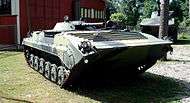 | Designated as Korshun. | |
| BTR-152 | Armored personnel carrier | N/A | | 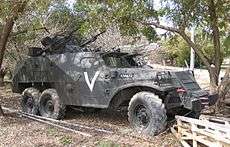 | ||
| BTR-50P | Armored personnel carrier | N/A | | 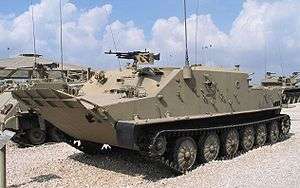 | ||
| BTR-60PB | Armored personnel carrier | 1,000[9] | | | First ordered in 1966. | |
| BTR-80A | Armored personnel carrier | 35[9] | | .jpg) | ||
| Type 55 | Armored personnel carrier | N/A | | 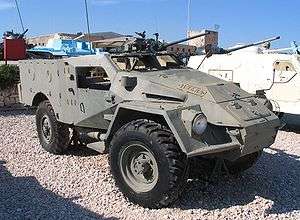 | ||
| Type 63 APC | Armored personnel carrier | 500[9] | | 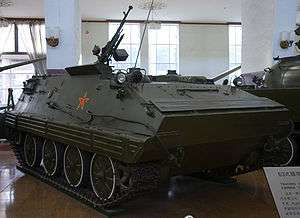 | Variant VTT-323 based on Chinese A531. | |
| M1992 | Armored personnel carrier | N/A | | | Locally designed APC based on the BRDM-2.[13] Armed with an AGS-17 grenade launcher and a 9K111 Fagot ATGM. | |
| VTT-323 (M-1973) | Armored personnel carrier | 3200 | |  | Based on the YW-531. | |
| M-2010 | Armored personnel carrier | 3200 | |  | Based on the VTT-323 but with longer chassis and improved optics. | |
Vehicles
| Name | Type | In Service | Notes | |||
|---|---|---|---|---|---|---|
| Transportation and logistics | ||||||
| Mercedes G-Class | Utility vehicle | Seen during the funeral of Kim Jong-il[14] | ||||
| Thairung TR MUV4 | Utility vehicle | |||||
| Ford Bronco | Utility vehicle | |||||
| UAZ-3151 | Utility vehicle | |||||
| ZIL-130 | General-purpose truck | |||||
| Iveco Eurocargo | General-purpose truck | |||||
| Ural-4320 | General-purpose truck | |||||
| ZIL-131 | Container semi-trailer truck | |||||
| Dongfeng 6x6 | Camp mobile dining car | |||||
| MAZ-7310 | Missile system carrier | |||||
| WS-51200 TEL | Transporter erector launcher platform | 10 | ||||
Artillery
The KPA-GF artillery pool include both imports and locally produced guns.
| Name | Type | In Service | Notes | |||
|---|---|---|---|---|---|---|
| Howitzers | ||||||
| M-1985 | 152 mm gun-howitzer | D-20/M1955; Type 83 | ||||
| M-1981 | 122 mm self-propelled gun | Type 54 SPH | ||||
| M-1978 | 170 mm SP gun-howitzer | Largest caliber howitzer in KPA service | ||||
| M-1975 | 130 mm self-propelled gun | |||||
| M-1974 | 152 mm SP gun-howitzer | |||||
| M-1992 | 130 mm self-propelled gun | |||||
| M-1991 | 122 mm self-propelled howitzer | |||||
| M-1992 | 120 mm self-propelled combination gun | |||||
| SU-100 | 100 mm SP assault gun | |||||
| Mortars | ||||||
| mortars | various ? | North Korea is known to have some 10,000 mortars of different types and origin in its inventory | ||||
| Rocket Artillery | ||||||
| Type 63 | 107 mm multiple rocket launcher | 4,000 delivered between 1964-1990 | ||||
| M-1985 | 122 mm multiple rocket launcher | |||||
| M-1993 | 122 mm multiple rocket launcher | |||||
| BM-11 | 122 mm multiple rocket launcher | |||||
| BMD-20 | 200 mm multiple rocket launcher | 200 delivered in mid-1950s[15] | ||||
| BM-24 | 240 mm multiple rocket launcher | 500 delivered in 1955 | ||||
| M1985/M1991 | 240 mm rocket launcher | Estimated 200+ in service between both models[16][17] | Range estimates of 30–43–60–70 km (19–27–37–43 mi)[18][19] | |||
| KN-09 | 300 mm rocket launcher | [20] | ||||
Weapons
Anti-tank weapons
| Name | ||||||
|---|---|---|---|---|---|---|
| Man-portable anti-tank | ||||||
| RPG-2 | ||||||
| RPG-7 (Local production) | ||||||
| Type 69 RPG Chinese rocket-propelled grenade | ||||||
| RPO-A (Local production?) | ||||||
| ATGMs | ||||||
| AT-1 Snapper | ||||||
| AT-2 Swatter | ||||||
| AT-3 Sagger | ||||||
| AT-4 Spigot | ||||||
| AT-5 Spandrel | ||||||
| Recoilless Rifles | ||||||
| B-10 recoilless rifle | ||||||
| B-11 recoilless rifle | ||||||
| SPG-9 | ||||||
| Self-propelled ATGMs | ||||||
| Type 85 Susang | ||||||
Anti-aircraft weapons
| Name | ||||||
|---|---|---|---|---|---|---|
| MANPADS | ||||||
| SA-7 MANPADS (Locally produced) | ||||||
| SA-14 MANPADS (Locally produced) | ||||||
| SA-16 MANPADS (Locally produced) | ||||||
| Anti-aircraft artillery | ||||||
| ZPU-4 | ||||||
| ZU-23-2 | ||||||
| M1939 | ||||||
| ZSU-57-2 | ||||||
| ZSU-23-4 | ||||||
| M1984 14.5mm (Locally produced) | ||||||
| M1985 57mm (Locally produced) | ||||||
| M1992 30mm (Locally produced) | ||||||
| M1992 37mm (Locally produced) | ||||||
Small arms
In South Korea, many of North Korean small arms are showcased in many war museums, such as War Memorial of Korea, tourist sites of North Korean infiltration tunnels, or for the purpose of inspiring patriotism to citizens. The Korean Defense Intelligence Command (KDIC) displays North Korean equipment (most of them used by Special Forces) on an exhibition van in various military-related events place such as military units or public establishments.[21]
| Name | Country of origin | Notes | ||||
|---|---|---|---|---|---|---|
| Semi-automatic pistols | ||||||
| Type 64 | | Unlicensed copy | ||||
| Type 66 | | Indigenous copy | ||||
| Type 68 | | Indigenous copy | ||||
| Type 70 | | Self-designed and produced; chambered in .32 ACP | ||||
| BaekDuSan | | Issued to high-ranking officers, pilots, and special force members | ||||
| Norinco NZ-75 | | |||||
| FN Baby Browning | | Issued to spies | ||||
| CZ 82 | | Issued to senior officers | ||||
| Inglis Hi-Power | | Issued to spies and special force members | ||||
| Ruger P-Series | | |||||
| M1911 pistol | | Issued to Kim Jong-un's bodyguards | ||||
| Sub-machine guns | ||||||
| PPS-43 | | Both Soviet PPS submachine guns and Chinese Type 54s | ||||
| M3 | | |||||
| M56 | | |||||
| Shotguns | ||||||
| KS-23 | | |||||
| Assault rifles | ||||||
| Type 56 | | |||||
| Norinco CQ | | Limited use, issued to special force members | ||||
| M16A1 | | Limited use, unlicensed locally made copies, issued to special force members | ||||
| Type 58 | | Standard issue of KPA reserve forces | ||||
| Type 68 | | Standard issue among North Korean infantry and being slowly supplanted by the Type 88 or 98 | ||||
| Type 98 | | Slowly supplanting the Type 68 as the future standard issue rifle of the KPA | ||||
| Sniper rifles | ||||||
| Dragunov SVD | | |||||
| PSL | | |||||
| Zastava M76 | | |||||
| Light machine guns | ||||||
| RPK | | Manufactured as Type 64 | ||||
| PKM | | |||||
| RPD | | |||||
| Type 73 | | Indigenous design based on the Vz. 52 machine gun and the Kalashnikov PK machine gun design | ||||
| Nikonov machine gun | | |||||
| RP-46 | | |||||
| Heavy machine guns | ||||||
| DShKM | | Standard issue | ||||
| KPV | | |||||
| Grenade launchers | ||||||
| GP-25 | | |||||
| AGS-17 | | |||||
Retired small arms
(Some probably kept in storage for Worker-Peasant Red Guards units)
- TT pistol - Soviet Union made Tokarev batches, replaced by the locally made Type 68 pistol.
- Type 54 pistol - Chinese made Tokarev batches, replaced by the locally made Type 68 pistol.
- PPSh-41 - Under the designation 'Type 49'
- Type 100 - Japanese sub-machine gun, captured during World War II and used in the Korean War.
- Mosin–Nagant - Now used for ceremonial purposes only
- PPD-40
- SVT-40
- SG-43 Goryunov
- DP
- Type 63 Rifle - Locally produced variant of the Soviet SKS carbine. Now used by ceremonial and reserve forces of the KPA.
Ranks and uniforms
Ranks
Korean People's Army Ground Forces has six categories of ranks; marshals, general officers, senior officers, junior officers, Non-commissioned Officers, and soldiers.
Enlisted
| NCOs | Soldiers | ||||||||
|---|---|---|---|---|---|---|---|---|---|
| |
|
|
|
|
|
|
| ||
| Ranks in Korean | T'ŭkmu-sangsa 특무상사 | Sangsa 상사 | Chungsa 중사 | Hasa 하사 | Sanggŭp-pyŏngsa 상급병사 | Chungŭp-pyŏngsa 중급병사 | Hagŭp-pyŏngsa 하급병사 | Chŏnsa 전사 | |
| Ranks | Chief Master Sergeant | Staff Sergeant | Sergeant | Junior Sergeant | Corporal First Class | Corporal | Lance corporal | Private | |
Officers
| Generals | Officers | ||||||||||||
|---|---|---|---|---|---|---|---|---|---|---|---|---|---|
| |
|
|
|
|
|
|
|
|
|
|
| ||
| Ranks in Korean | Taejang 대장 | Sangjang 상장 | Chungjang 중장 | Sojang 소장 | Taejwa 대좌 | Sangjwa 상좌 | Chungjwa 중좌 | Sojwa 소좌 | Taewi 대위 | Sangwi 상위 | Chungwi 중위 | Sowi 소위 | |
| Ranks | General of the Army | Colonel General | Lieutenant General | Major General | Senior Colonel | Colonel | Lieutenant Colonel | Major | Captain | Senior Lieutenant | Lieutenant | Junior Lieutenant | |
Marshals
The Vice Marshal rank was created for a combined political-military position.
The Marshal of the KPA rank was created for a combined honorary promotion of political-military position.
Supreme commanders ranks are Marshal of the DPRK and Generalissimo.
| Supreme commanders | Marshals | |||
|---|---|---|---|---|
| |
|
|
| |
| Ranks in Korean | Tae wonsu 대원수 | Konghwaguk Wonsu 공화국원수 | Wonsu 원수 | Ch'asu 차수 |
| Ranks | Generalissimo | Marshal of the DPRK | Marshal of the KPA | Vice Marshal |
Uniform
KPA officers and soldiers are most often seen wearing a mix of olive green or tan uniforms. The basic dress uniform consists of a tunic and pants (white tunics for general officers in special occasions); female soldiers wear knee length skirts but can sometimes wear pants.
Caps or peaked caps, especially for officers (and sometimes berets for women) are worn in spring and summer months and a Russian style fur hat (the Ushanka hats) in winter. A variant of the Disruptive Pattern Material, the Disruptive Pattern Combat Uniform (green), the ERDL pattern, the M81 Woodland and the Tigerstripe is also being worn by a few and rare images of North Korean army officers and service personnel. In Non-Dress uniforms a steel helmet (Soviet SSh68 combat helmet) seems to be the most common headgear, and is sometimes worn with a camouflage covering.
Standard military boots are worn for combat, women wear low heel shoes or heel boots for formal parades.
Camouflage uniforms are slowly becoming more common in the KPA. During the April 15, 2012 parade, Kevlar helmets were displayed in certain KPA units.
See also
- Republic of Korea Army
- Korean Peoples Army
- Korean Peoples Navy
- Korean People's Army Air Force
- Korean People's Army Strategic Force
- North Korean Special Operation Force
- Worker-Peasant Red Guards
References
- ↑ https://www.enca.com/world/north-korean-military-takes-oath-loyalty
- ↑ http://www.koreatimes.co.kr/www/news/nation/2016/03/485_201090.html
- ↑ Federation of American Scientists, Korean Peoples' Army, accessed February 2008
- ↑ Joseph F. Bermudez, Shield of the Great Leader, 2001, 59.
- ↑ http://www.dailynk.com/english/read.php?num=7321&cataId=nk02100
- ↑ Hodge, Homer T., "North Korea's Military Strategy", Hodge: 2003.
- ↑ "MILITARY AND SECURITY DEVELOPMENTS INVOLVING THE DEMOCRATIC PEOPLE'S REPUBLIC OF KOREA". http://www.defense.gov/pubs/North_Korea_Military_Power_Report_2013-2014.pdf. External link in
|website=(help); - ↑ http://www.defense.gov/Portals/1/Documents/pubs/North_Korea_Military_Power_Report_2013-2014.pdf
- 1 2 3 4 5 6 7 "SIPRI arms transfer database". Stockholm International Peace Research Institute. 6 November 2013. Retrieved 1 May 2016.
- ↑ Christopher F Foss. Jane's Armour and Artillery 2005-2006.
- ↑ KPA Journal Vol. 2, No. 12 - December 2013
- ↑ North Korean Army Tanks, Vehicles and Artillery Since 1950. Military Factory. 9 May 2014. Retrieved 28 April 2015.
- ↑ M1992 - Military-Today.com
- ↑ IBtimes.com "Kim Jong-il's Funeral Held in N. Korea"
- ↑ BMD-20 - Military-Today.com
- ↑ The North Korean M1985 MLRS & M1991 MLRS - Tanknutdave.com
- ↑ M1985 - Military-Today.com
- ↑ M-1991 240mm Juche 100 MRLS Multiple Rocket launcher System - Armyrecognition.com
- ↑ North Korea deploys new 240mm artillery rocket launcher systems along border with South Korea - Armyrecognition.com, 30 June 2013
- ↑ The threat of North Korea’s new rocket artillery - NKnews.org, 13 March 2014
- ↑ "N. Korean special operation forces infiltration van showcased for 19th ESC senior leader development". DVIDS - Defense Video & Imagery Distribution System. 4 Aug 2014.
- Robert A. Scalapino, Chong-Sik Lee, Communism in Korea: The society, University of California Press, 1972 - Political Science
External links
| Wikimedia Commons has media related to Korean People's Army Ground Force. |
- Military and Security Developments Involving the Democratic People's Republic of Korea 2012
- Military and Security Developments Involving the Democratic People's Republic of Korea 2013
